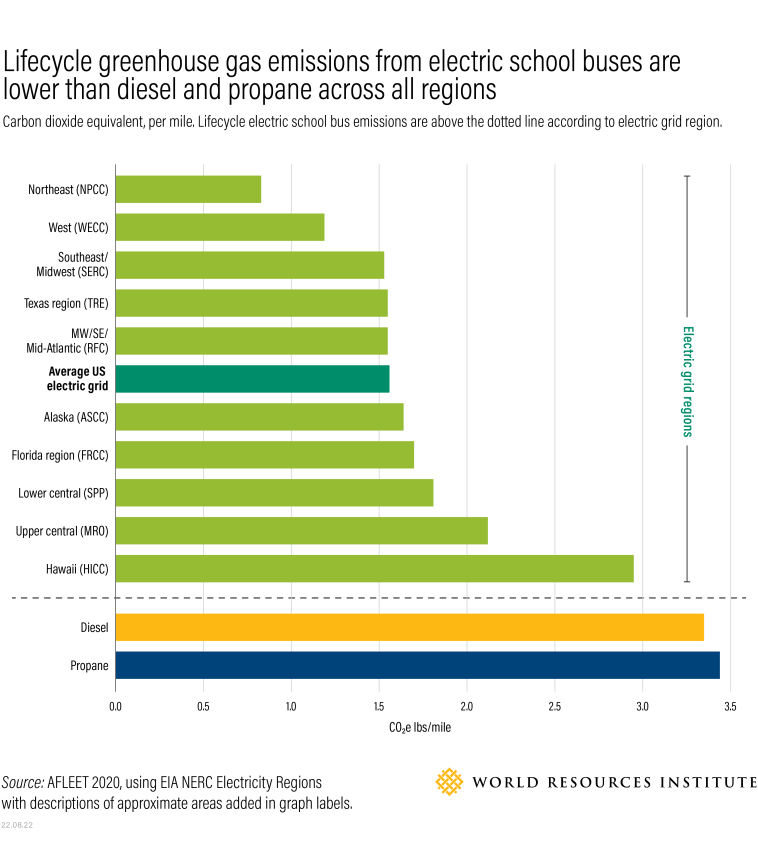Why We Need Electric School Buses
Students deserve a clean, healthy ride to school – and the transition must start with those most impacted.

In a typical school year, more than 20 million students ride the bus to school each day, taking more than 7 billion combined trips. But right now, most of those school buses burn polluting diesel fuel, and kids from underserved communities bear a disproportionate burden of the related emissions.
Diesel-burning school buses pose real risks to our kids and communities. That’s why it’s time to act.
Children’s health
The exhaust from diesel-burning school buses hurts students’ health, putting them at risk for serious conditions like cancer and asthma.
That’s because diesel exhaust pollution includes high levels of nitrogen oxides and other pollutants. Nitrogen oxides can cause respiratory and heart disease, and as diesel-burning school buses drive their routes, these toxic air pollutants stay in the cabin of the vehicle — exposing children to this danger for extended periods of time.
Today, over 90% of the school buses on the road burn diesel fuel. That's a problem because diesel exhaust pollution is dangerous for kids.
In fact, diesel exhaust pollution is so dangerous, the World Health Organization has labeled it a known carcinogen. And one study found that higher ambient air pollution levels overall has a similar impact on lung function as maternal smoking.
Student learning
Diesel exhaust pollution is also linked to negative impacts on brain development, which puts students' learning at risk. Research has shown that by reducing students’ exposure to school bus pollution, schools can improve student test scores — and the impact is on par with having smaller class sizes and more experienced teachers.
In addition, asthma, which can be caused by diesel exhaust pollution, is one of the leading causes of absenteeism from school.
Diesel exhaust pollution can cause asthma in children, endangering their health and causing them to miss school.
It’s clear: No child should be forced to breathe harmful toxins from diesel exhaust pollution on their ride to school.
Climate
Diesel-burning school buses also emit high levels of greenhouse gases like carbon dioxide, contributing to the dangers of climate change and threatening to leave current and future generations with a less safe and less habitable world.
On a lifecycle basis, electric school buses produce less than half the greenhouse gas (GHG) emissions of both propane- and diesel-burning school buses. In fact, on every single electric grid in the U.S., electric school buses generate lower levels of greenhouse gas emissions on a lifecycle basis.

Cost
Diesel-burning school buses have higher maintenance and fuel costs than electric school buses over time. In fact, our research suggests that electric school buses save districts an average of $100,000 in fuel and maintenance costs over the life of the bus.
When paired with funding and financing opportunities that help cover the higher upfront purchase price for electric school buses, the total cost of ownership (TCO) for electric school buses can be hundreds of thousands of dollars less than for diesel-burning school buses. This provides cost savings that can be reinvested back into classrooms.
By combining funding, financing, and operational cost savings, school districts across the U.S. are finding that electric school buses aren’t just good for their students’ health — they’re good for the bottom line!
The total cost of ownership (TCO) for electric school buses can be hundreds of thousands of dollars less than for diesel-burning school buses.
The answer: an equitable transition to electric school buses
Despite the challenges posed by diesel-burning school buses, there’s good news. Electric school buses offer a cleaner, healthier option for students.
Electric school buses have zero tailpipe emissions, reducing students’ exposure to the dangers of diesel exhaust pollution. Electric school buses are responsible for significantly lower levels of greenhouse gases than diesel-burning school buses. And with significantly lower fuel and maintenance costs, electric school buses give districts an opportunity to save money and reinvest in classrooms.
Best of all, they’re ready today: Electric school buses are successfully operating in every part of the country and in all types of climates throughout the U.S., including urban, rural, and suburban communities.
There is evidence that children are particularly susceptible to the negative health impacts of diesel exhaust.
Every student deserves a clean ride to school, free from the dangers of diesel exhaust pollution. But not everyone has been impacted by diesel exhaust and air pollution equally.
Decades of racist, discriminatory policies have led to communities of color and low-income communities experiencing more toxic air pollution than the rest of the country. When it comes to school transportation and on-road pollution, these trends persist: Black students and low-income students rely on diesel-burning school buses more than others, meaning they face more direct exposure to diesel exhaust pollution from these buses. More broadly, communities of color face on-road fine particulate matter pollution that is 61% to 75% higher than for white residents. So it’s no surprise that communities of color in the U.S. experienced 7.5x higher pediatric asthma rates compared with mostly white communities.
Students with disabilities are also disproportionately impacted by dangerous exhaust pollution from diesel-burning school buses, because they are more likely to ride buses to school and more likely to travel long distances on a school bus.
To help address these historic and ongoing wrongs, the transition away from diesel-burning school buses to electric school buses must be equitable. That means communities most impacted by diesel exhaust pollution should have access to the benefits of electric school buses first — and that communities affected by this transition are engaged throughout the process.
As the only type of school bus not powered by a fossil fuel-burning engine, electric school buses have zero tailpipe emissions of any pollutant.
Electric school buses represent a real opportunity to bring health, climate, and cost benefits to every student and every community in America, starting with those most impacted by the dangers of diesel exhaust pollution.
With funding and financing now available for electric school buses, communities across the country are already seeing the tangible benefits of electric school buses.
It’s clear: The electric school bus moment is here!
Learn more
Ready to find out more about the electric school bus moment and how you can be part of the equitable transition to electric school buses?
Learn more about electric school buses
Want to know more about these powerful, innovative school buses? Dive in:
Learn more from those who are bringing electric school buses to their communities
In communities across the country, school districts and students are working to bring the benefits of electric school buses to their streets. Here’s how:
Learn more about why the transition to electric school buses must be equitable
Everyone is impacted by the harms of diesel exhaust pollution. But those impacts aren’t felt equally. Learn why the transition to electric school buses must be equitable:
Learn more about the organizations leading the way
Learn more about some of the organizations that have worked for years to get electric school buses on the agenda — and on the road: Leading The Charge: Advocacy Organizations at the Forefront of the Electric School Bus Transition
*Calculation using AFLEET (2020) and includes fuel lifecycle and vehicle operations. Uses the NREL Electrification Futures Study low cost renewables 2030 national average values, and assumes annual bus mileage of 14,084 miles, the same distribution of bus sizes found in the 2022 fleet orders, and no changes from current fuel efficiencies of either fuel type.